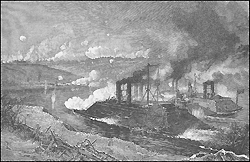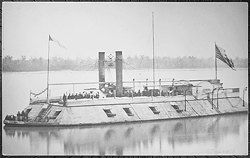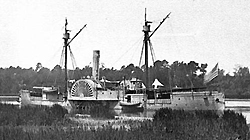
|
|
Home American Civil War Civil War Time Line Battle of Fort Sumter Battle of Gettysburg Battle of Vicksburg Battle of Johnsonville Battle of Shiloh Battle of Belmont Gunboats |
Gunboats  In the age of sail, a gunboat was usually a small undecked vessel carrying a single smoothbore cannon in the bow, or just two or three such cannons. A gunboat could carry one or two masts or be oar-powered only, but the single-masted version of about 50 ft length was most typical. Some types of gunboats carried two cannons, or else mounted a number of swivel guns on the railings.
In the age of sail, a gunboat was usually a small undecked vessel carrying a single smoothbore cannon in the bow, or just two or three such cannons. A gunboat could carry one or two masts or be oar-powered only, but the single-masted version of about 50 ft length was most typical. Some types of gunboats carried two cannons, or else mounted a number of swivel guns on the railings.
The advantages of this type of gunboat were that since it only carried a single cannon, that cannon could be quite heavy -- for instance a 32-pounder -- and that the boat could be maneuvered in shallow or restricted waters, where sailing was difficult for larger ships. A single hit from a frigate would demolish a gunboat, but a frigate facing a half-dozen gunboats in an estuary would likely be seriously damaged before it could manage to sink all of them. Gunboats were also easy and quick to build; the combatants in the 1776 Battle of Valcour Island on New York's Lake Champlain were mostly gunboats built on the spot. All navies of the sailing era kept a number of gunboats on hand. Gunboats were a key part of the planned Napoleon's invasion of England in 1804, and were heavily used by Denmark-Norway. Between 1803 and 1812, the US Navy had a policy of basing the naval forces on coastal gunboats, and experimented with a variety of designs, but they were nearly useless in the War of 1812, and went back to being special-purpose vessels.  Gunboats experienced a revival in the American Civil War, and was commonly used for armed sidewheel steamers. At first these were quickly converted from existing passenger-carrying boats, but later some boats were purposely built, such as the USS Miami (1861). They all frequently mounted a dozen guns or more, sometimes of rather large caliber, and were usually armored.
Gunboats experienced a revival in the American Civil War, and was commonly used for armed sidewheel steamers. At first these were quickly converted from existing passenger-carrying boats, but later some boats were purposely built, such as the USS Miami (1861). They all frequently mounted a dozen guns or more, sometimes of rather large caliber, and were usually armored.
With the introduction of steam power in the early 19th century, small vessels propelled by side paddles and later by screws were built in considerable numbers by the Royal Navy and other navies. These retained full sailing rigs, so that steam propulsion was used as an auxiliary form. In the later 19th century and early 20th century, "gunboat" was the common name for smaller armed vessels, often called "patrol gunboats". These could be classified, from the smallest to the largest, into river gunboats, river monitors, coastal defense gunboats (such as the SMS Panther), and full-fledged monitors for coastal bombardments. When there would be few opportunities to re-coal, vessels carrying a full sailing rig were still used as gunboats; HMS Gannet, a sloop preserved at Chatham Historic Dockyard in the United Kingdom, is an example of this type of gunboat.  In the US Navy, these boats had the hull classification symbol "PG"; they usually displaced under 2,000 tons, were about 200 ft long, 10-15 feet draft and sometimes much less, and mounted several guns of caliber up to 5-6 inches. An important characteristic of these was the ability to operate in rivers, enabling them to reach inland targets in a way not otherwise possible before the development of aircraft. In this period, gunboats were used by the naval powers for police actions in colonies or weaker countries, for example in China. It is this category of gunboat that inspired the term "gunboat diplomacy". With the addition of torpedoes they became torpedo gunboats.
In the US Navy, these boats had the hull classification symbol "PG"; they usually displaced under 2,000 tons, were about 200 ft long, 10-15 feet draft and sometimes much less, and mounted several guns of caliber up to 5-6 inches. An important characteristic of these was the ability to operate in rivers, enabling them to reach inland targets in a way not otherwise possible before the development of aircraft. In this period, gunboats were used by the naval powers for police actions in colonies or weaker countries, for example in China. It is this category of gunboat that inspired the term "gunboat diplomacy". With the addition of torpedoes they became torpedo gunboats.
During the Second World War the gunboat was for the Royal Navy a vessel identical to torpedo boats, but equipped with machine guns and larger weapons up to 57 mm in calibre for attacking enemy torpedo boats or small craft - the Motor Gun Boat (MGB). Post-World War II, the terms "motor gunboat" came to be used for smaller vessels, with displacements in the 50-ton range. US river gunboats in the Vietnam War, utilizing boats with mostly fiberglass hulls in the 9-ton range, became known as the "Brownwater Navy". Gunboats are still being built and operated around the world today, albeit mainly used for coast guard duties. |
|
|
(GNU Free Documentation License, Wikimedia Foundation, Inc.) |